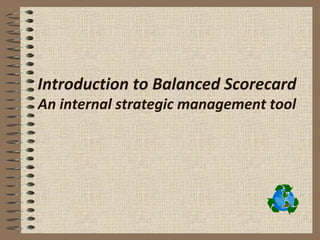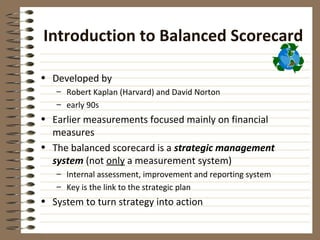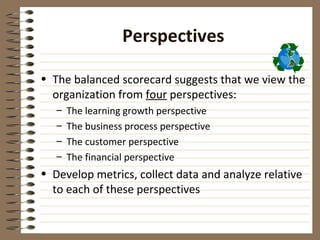Intro to balanced scorecard
- 1. Introduction to Balanced Scorecard An internal strategic management tool
- 2. Introduction to Balanced Scorecard • Developed by – Robert Kaplan (Harvard) and David Norton – early 90s • Earlier measurements focused mainly on financial measures • The balanced scorecard is a strategic management system (not only a measurement system) – Internal assessment, improvement and reporting system – Key is the link to the strategic plan • System to turn strategy into action
- 3. • The balanced scorecard retains traditional financial measures. But financial measures tell the story of past events, an adequate story for industrial age companies for which investments in long-term capabilities and customer relationships were not critical for success. These financial measures are inadequate, however, for guiding and evaluating the journey that information age companies must make to create future value through investment in customers, suppliers, employees, processes, technology, and innovation. Kaplan & Norton
- 4. How does a Balanced Scorecard help? • Comprehensive view of the organization – Covers financial and non-financial perspectives – Covers short-term and long-term planning and measurement • Lag and lead indicators • Translating the vision – Forces managers to agree on metrics for operationalizing company vision • Communicating and linking – Connects individual and departmental performance measures to corporate vision • Business Planning – Integration of functions so that budgets support long term goals • Feedback and Learning – Helps course correction and rethink measures
- 5. Perspectives • The balanced scorecard suggests that we view the organization from four perspectives: – The learning growth perspective – The business process perspective – The customer perspective – The financial perspective • Develop metrics, collect data and analyze relative to each of these perspectives
- 7. Learning and Growth Perspective • Development of the human resources – This perspective supports the concept that people are a company's main resource and most valuable asset – metrics defined for this perspective must measure various aspects of employee improvement, growth, and satisfaction. • personnel training and improvement • cultivation of corporate culture • organizational development, including the nurturing of corporate experts, gurus, and mentors • setting up of fast and efficient knowledge transfer infrastructure • opening up of communication lines among personnel
- 8. Business Processes Perspective • Internal business processes – These metrics, which measure various aspects (efficiency, speed, quality, etc.) of how well the company's products, services and internal support systems are produced or delivered
- 9. The Customer Perspective • Focus on customer satisfaction. – Rigorous data analysis to understand the customer – Difficult to reflect the true sentiment of the customer
- 10. Financial Perspective • Indicates if the transformation of strategy leads to economic success • Define the financial performance that the strategy is to achieve – Revenue growth – Cost reduction • Cost reduction from energy efficiency • Measures the effectiveness of the other perspectives
- 11. Characteristics of good metrics • reflect the true present status of the company from many different perspectives • provide constructive feedback to various company processes, leading to continuous improvement • show trends in company performance over time, facilitating adjustments to changes • quantify many things, making analyses more accurate and solutions more effective
- 12. Close the loop • Once the metrics have been defined and implemented • scorecard data becomes available • follow-through becomes imperative • Movements in the metrics must be analyzed to identify their causes • Causes that produce positive (negative) changes must be sustained or enhanced (eliminated)












